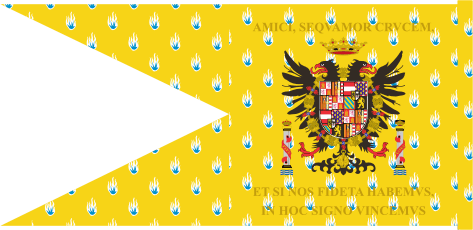.gif)
by Juan Manuel Gabino Villascán, July 2005.

Last modified: 2005-07-23 by juan manuel gabino villascán
Keywords: mexico | spain | cortés (hernán/fernando) | conquista | mary | standard | conquest | labaro | malinche |
Links: FOTW homepage |
search |
disclaimer and copyright |
write us |
mirrors
.gif)
by Juan Manuel Gabino Villascán, July 2005.


by Juan Manuel Gabino Villascán, July 2005.
"Andrés Tapia's chronicle says that The flag of Coqueror Cortés was 'of certain white-and-blue fires, and a red cross in the middle; and a motto read: Amici, sequamur crucem, et si nos fidem, vere in hoc signo vicemus [Fellows, let's follow the cross, since if we have faith, by this sign we conquer]'.
" 'In front of his house's entrance [Cortés] hoisted a magnificent velvet-and-gold standard with the sign of the cross and the Royal Arms ebroided on it, and with the Latin motto: Hermanos: sigamos la señal de la cruz, que con ella venceremos [Brothers, let's follow the sign of the cross, by we coquer]'.
"Mendieta, in his Historia Eclesiástica Indiana: When [Cortés] departed from the island of Cuba to carry it [the Conquista] on, in all flags of his ships placed in the middle of his arms a red cross with a lettering that read: Amici, sequamur crucem; si enim fidem habuerimus, in hoc signo vincemus.
"Betancourt, en his Teatro mexicano: '[Cortés] set sail toward Trinidad, where he arrive after few days; he took off the flags and standard he had made for its own, consisting of the royal arms and a cross is each face respectivelly, and a lettering in Latin that red: Let's follow the Holy Cross, since by her we conquer'.
"Beaumont, in the chronicle of the provinces of Holy Apostles Saint Peter and Sant Paul writes: '[Cortés] ordered to pint on his standards a cross and the sames words once appeared to Constantine the Great: In hoc signo vice' ".
Rocalla de Historia,
Salado Álvarez Victoriano
Cien de México, CONACULTA, México, 1992. pp 64-66.
Translated and reported by Juan Manuel Gabino Villascán, July 2005.
"The leader ship was a hondrend tons, other three eighty and seventy tons, ther remainder were small and deckless, plus some brigs. The flag that Cortés flew in this journey was of white-and-blue fires with a red cross in the middle, surrounded by a Latin lettering, which romanized says: Friends, let's follow the cross, since if we have faith in this sign, we conquer."
Historia de la Conquista de México,
López de Gómara Francisco
Sepan cuantos, Porrúa, México, 1997. p 18.
Translated and reported by Juan Manuel Gabino Villascán, July 2005.
"Then he [Cortés] ordered to make two standards and flags embroidered of gold withe the royal arms and a cross in each side respectivelly, and the motto: 'Brothers and comrades, let's follow the sign of the Holy Cross with true faith, since by her we conquer.' "
Historia verdadera de la Conquista de la Nueva España,
Díaz del Castillo Bernal
Editores Mexicanos Unidos, México, 1992. p 53.
Translated and reported by Juan Manuel Gabino Villascán, July 2005.
The conquerer, before leaving Santiago de Cuba, brought
a small flag that, after remaining a few months in what
would become New Spain, changed for another with the image
of the Holy Virgin, which he worshiped. This labaro
was the one he used throughout the Conquest.
Jorge Candeias, 27 Oct 1997, translating from
La
Bandera Mexicana website
1- Hernan Cortes Standard, 1519-1521. This flag is kept at the Castle of Chapultepec, Mexico. Red with an image of the Virgin Mary. The leyend ESTE ESTANDARTE FUE EL QUE TRAJO DON FERNADO CORTES EN LA CONQUISTA DE MEJICO (this standard was the one carried by fernando cortes in the conquest of mexico) was embroidered leter.
2- Cavalry standard of the conquest of Mexico, 1519-1521. Swallow-tailed red flag with a representation of the Holy Spirit (pigeon). Codice Azcatitlan, National Library, Paris, France.
Banderas de España,
José Luis Calvo Pérez and Luis Gránvalos González
Silex, España, 1983. pp 56-57.
Translated and reported by Jose C. Alegria, July 2005.